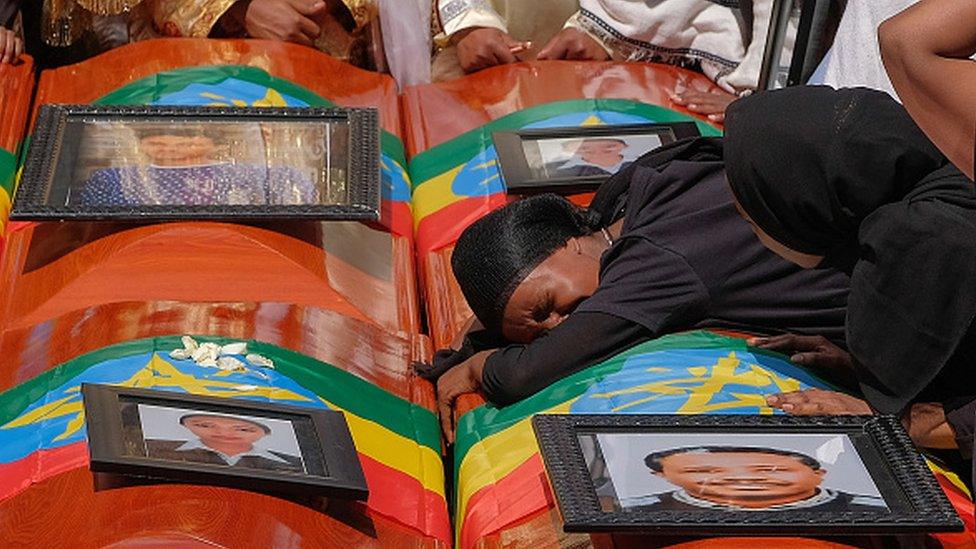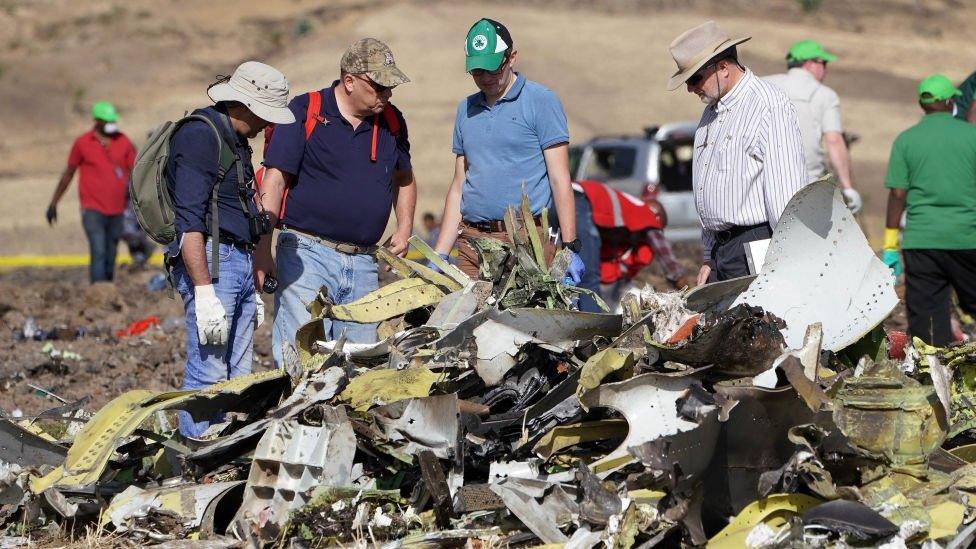Boeing crashes: Pilot 'Sully' knows of desperate fight for life
- Published

Chelsey Sullenberger was played by Tom Hanks in a movie about safely landing a passenger plane on New York's Hudson River
A pilot whose heroics became a Hollywood film says he knows the desperation that engulfed the cockpits on Boeing's two doomed 737 Max planes.
Captain Chesley Sullenberger said flight control flaws would have left the pilots in a "fight for their lives" and unable to quickly grasp why the aircraft were not responding.
He was speaking at a US Congressional hearing into the two fatal crashes.
The movie "Sully" is about his landing of a passenger jet on a New York river.
He told the committee: "I'm one of a relatively small group of people who have experienced such a crisis and lived to share what we learned about it.
"I can tell you first hand that the startle-factor is real, and it's huge. And it absolutely and it quickly interferes with one's ability to quickly analyse the crisis and take effective action.
"Within seconds, these crews would have been fighting for their lives in the fight of their lives."
Preliminary reports into both accidents have suggested the disasters were triggered by a flight control override system deploying at the wrong time, due to a faulty sensor.
Last month, Congressman Sam Graves argued that "facts in the preliminary report reveal pilot error as a factor".
But on Wednesday, Mr Sullenberger strongly rejected the suggestion.
While everyone has a duty to keep passengers and crew safe, he said, "first, we should design aircraft for them to crew that do not have inadvertent traps set for them".
The failure of single sensor reading "quickly caused multiple instrument indication anomalies and sudden loud, and in some cases false warnings, creating major distractions... making it harder to quickly analyse the situation and take effective corrective action."
He recently went through the cockpit scenario in a Max simulator and said that even knowing what was going to happen, "I could see how crews would have run out of time before they could have solved the problem".
The US Federal Aviation Authority has been criticised for its lack of oversight and the certification process that cleared the Max to fly.

All 157 passengers and crew were killed when flight ET302 went down shortly after take-off
All Boeing 737 Max planes were grounded in March after an Ethiopian Airlines flight crashed, killing 157 people.
Five months earlier, 189 people were killed when a Boeing 737 Max operated by Lion Air crashed.
Mr Sullenberger said there was a multiple chain of events that caused the two crashes. But he added that the chain "began many years ago with the decision to upgrade a half-century old design".
"These crashes are demonstrable evidence that our current system of design and certification has failed us," he told the committee.
Boeing is working with regulators to get the Max back in the air as soon as possible.
But Mr Sullenberger said he did not expect accident investigators to complete their work for many months, putting a question mark over whether the aircraft can resume flights before the end of the year.
He called for better pilot training before 737 Max is cleared to fly, saying that just reviewing Boeing's modifications to the aircraft on a computer was insufficient.
"Pilots must develop the muscle memory to be able to quickly and effectively respond to a sudden emergency," Mr Sullenberger told the House of Representatives subcommittee hearing. "Reading about it on an iPad is not even close to sufficient; pilots must experience it physically, firsthand," he said.
The hearing was the third by Congress into the crashes, and again focused on the Maneuvering Characteristics Augmentation System (MCAS).
In both Max crashes, the MCAS pointed the plane sharply downward based on a faulty sensor reading, hindering the pilots' effort to control the aircraft after takeoff.
- Published17 June 2019
